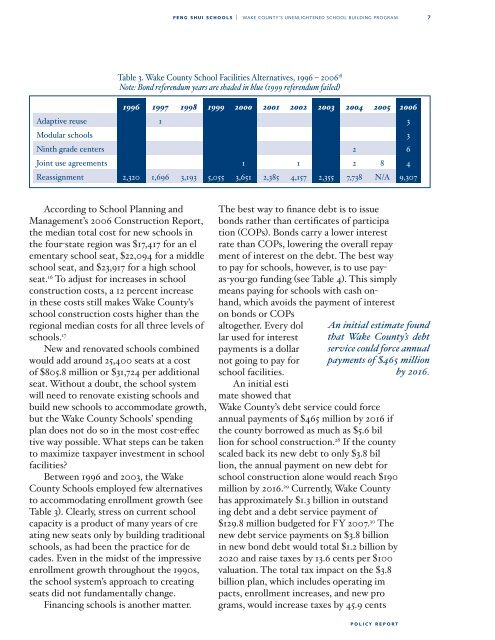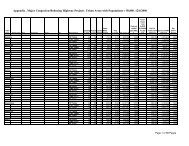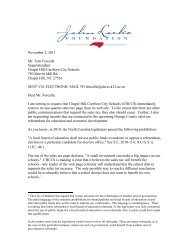Feng Shui Schools - John Locke Foundation
Feng Shui Schools - John Locke Foundation
Feng Shui Schools - John Locke Foundation
Create successful ePaper yourself
Turn your PDF publications into a flip-book with our unique Google optimized e-Paper software.
f e n g s h u i s c h o o l s |<br />
wake County’s unenlightened school building program<br />
<br />
Table 3. Wake County School Facilities Alternatives, 1996 – 2006 18<br />
Note: Bond referendum years are shaded in blue (1999 referendum failed)<br />
1996 1997 1998 1999 2000 2001 2002 2003 2004 2005 2006<br />
Adaptive reuse 1 3<br />
Modular schools 3<br />
Ninth grade centers 2 6<br />
Joint use agreements 1 1 2 2 8 4<br />
Reassignment 2,320 1,696 3,193 5,055 3,651 2,385 4,157 2,355 7,738 N/A 9,307<br />
According to School Planning and<br />
Management’s 2006 Construction Report,<br />
the median total cost for new schools in<br />
the four-state region was $17,417 for an elementary<br />
school seat, $22,094 for a middle<br />
school seat, and $23,917 for a high school<br />
seat. 16 To adjust for increases in school<br />
construction costs, a 12 percent increase<br />
in these costs still makes Wake County’s<br />
school construction costs higher than the<br />
regional median costs for all three levels of<br />
schools. 17<br />
New and renovated schools combined<br />
would add around 25,400 seats at a cost<br />
of $805.8 million or $31,724 per additional<br />
seat. Without a doubt, the school system<br />
will need to renovate existing schools and<br />
build new schools to accommodate growth,<br />
but the Wake County <strong>Schools</strong>’ spending<br />
plan does not do so in the most cost-effective<br />
way possible. What steps can be taken<br />
to maximize taxpayer investment in school<br />
facilities?<br />
Between 1996 and 2003, the Wake<br />
County <strong>Schools</strong> employed few alternatives<br />
to accommodating enrollment growth (see<br />
Table 3). Clearly, stress on current school<br />
capacity is a product of many years of creating<br />
new seats only by building traditional<br />
schools, as had been the practice for decades.<br />
Even in the midst of the impressive<br />
enrollment growth throughout the 1990s,<br />
the school system’s approach to creating<br />
seats did not fundamentally change.<br />
Financing schools is another matter.<br />
The best way to finance debt is to issue<br />
bonds rather than certificates of participation<br />
(COPs). Bonds carry a lower interest<br />
rate than COPs, lowering the overall repayment<br />
of interest on the debt. The best way<br />
to pay for schools, however, is to use payas-you-go<br />
funding (see Table 4). This simply<br />
means paying for schools with cash onhand,<br />
which avoids the payment of interest<br />
on bonds or COPs<br />
altogether. Every dollar<br />
used for interest<br />
payments is a dollar<br />
not going to pay for<br />
school facilities.<br />
An initial estimate<br />
showed that<br />
Wake County’s debt service could force<br />
annual payments of $465 million by 2016 if<br />
the county borrowed as much as $5.6 billion<br />
for school construction. 28 If the county<br />
scaled back its new debt to only $3.8 billion,<br />
the annual payment on new debt for<br />
school construction alone would reach $190<br />
million by 2016. 29 Currently, Wake County<br />
has approximately $1.3 billion in outstanding<br />
debt and a debt service payment of<br />
$129.8 million budgeted for FY 2007. 30 The<br />
new debt service payments on $3.8 billion<br />
in new bond debt would total $1.2 billion by<br />
2020 and raise taxes by 13.6 cents per $100<br />
valuation. The total tax impact on the $3.8<br />
billion plan, which includes operating impacts,<br />
enrollment increases, and new programs,<br />
would increase taxes by 45.9 cents<br />
An initial estimate found<br />
that Wake County’s debt<br />
service could force annual<br />
payments of $465 million<br />
by 2016.<br />
p o l i c y r e p o r t










